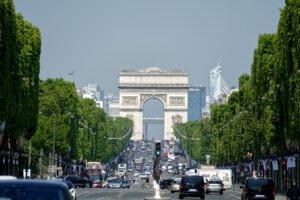I’d argue that the bridge in Avignon that everyone had to at least verbally dance on is the most famous overpass in the entire world. Show me one child who did not mumble something that sounded more or less like sir ly pong davynong already in kindergarten. Later, you probably had to translate in your French class that everyone is dancing on that stupid bridge. Only, if you were to actually dance across it, you’d end up in the Rhône river! This bridge is broken and only a part is walkable; or danceable, if you prefer.
Anyway, this is not the only surprise the majestic city of Avignon has in store.
So put on your dancing shoes and let’s see what not to miss when visiting Avignon – even if it’s for just one day.

When It Rains, It Pours
When you arrive in a city for the first time, and you find yourself a little lost between the ongoing renovation work at the train station.
The clerk at the convenience store casually tells you that there is no luggage storage in the entire city.
As you step onto the station forecourt, it pours down on you from deep gray clouds.

When you’re dragging your heavy backpack down the main street through the rain, the humidity gets into your jacket and you accidentally soak your right sneaker in a puddle.
Despite your desolate condition, you desperately ask at the nearest hotel if they can store your backpack there for a few hours although you’re not a guest.
When you then step outside after the blasé lady has handed you the pick-up ticket with a slightly condescending gesture and you still have an eye for how beautiful this city is, then you are probably in Avignon.
Yes, Avignon tested me with a very unfavorable entry but it still melted my heart.
Visiting a Myth
You probably have heard of Avignon. Everybody does, albeit mostly for the wrong reason, namely this dancing song.
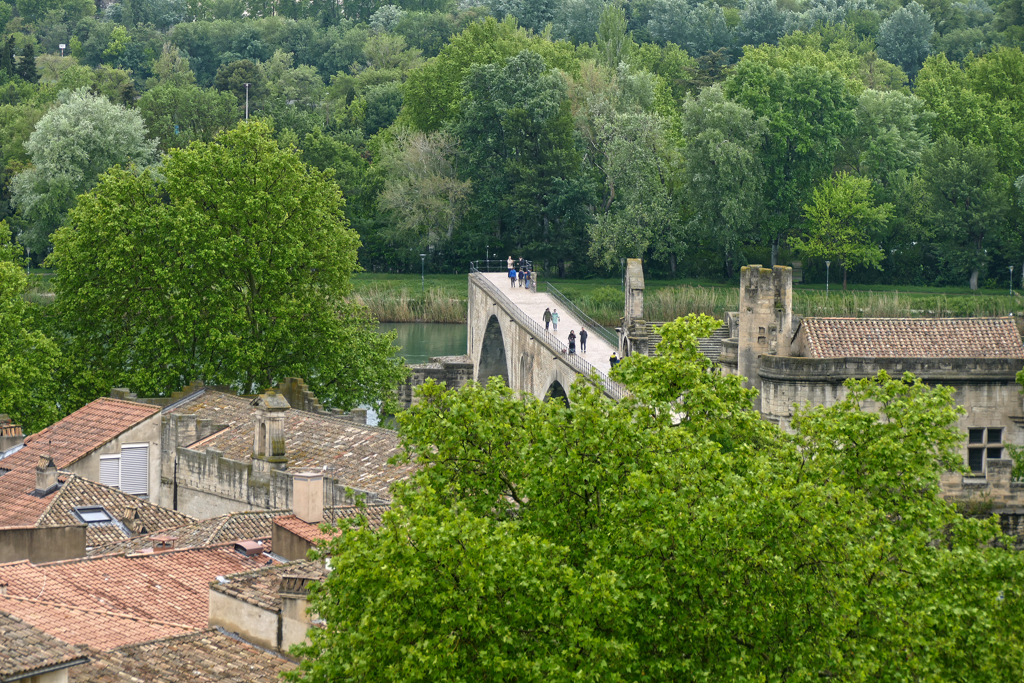
When preparing for my trip to Provence, I was amazed at what awaited me in this city. Not only had Avignon been the seat of Popes, it is also known far beyond France for its annual theater festival. Avignon was also the European Capital of Culture in 2000.
Due to the strong Catholic presence in the past centuries, the number of religious buildings is quite impressive. Also, I heard about painted windows and an incredible number of little patron saints on literally every corner. Avignon is called the city of the popes, the city of theater, the city of murals, and the city of Marian figures.

Oh yes, and then there is the bridge.
Popes in Avignon
Today, we take it for granted that the Pope is Catholic has his seat in Rome, hence, hardly anyone realizes that for several decades, Avignon was the base of the Pontifex Maximus. During the time of the influential French King Philip IV, Cardinal Clement V was elected pope in 1305 and held that job until 1314. However, in 1309 he moved his residence to Avignon.
It was not until 1378 that another papal election took place in Rome. Nonetheless, until 1429, there still remained several antipopes in Avignon, Peñíscola, and Armagnac.

In total, nine popes inhabited the magnificent papal palace in Avignon. To this date, it is nicknamed the City of the Popes, and the palace remains a symbol of the prestige of Christianity. It is the most important Gothic building ever created. With its 15,000 square meters, it is the size of four Cathedrals, after all!

An Unmissable Visit
The palace, which deems more of a stronghold, includes halls and areas that are now open to the public. You’ll walk through large staterooms that were the venue for ceremonies and banquets. Also, you get to see treasuries, chapels, and private apartments of the popes which are still decorated with invaluable frescoes.

The frescoes in the chapels of St. John and St. Martial are attributed to the Italian artist Matteo Giovannetti and are particularly very well preserved.

Otherwise, the building is largely empty today. To be able to imagine the past splendor, visitors are given a touchscreen tablet that shows them virtual replicas of the rooms including beautifully painted walls, sumptuous furnishing, and precious accessories. It is an absolutely fascinating immersive experience!
Your French is only basic? Don’t worry, the tablet is available in seven languages.

The Palais des Papes opens its gates every day from 9 a.m. to 7 p.m. The general entrance fee is for the Palast alone 12 €uros and for the gardens another 5 €uros. However, there is a combined ticket for the entire complex that will cost you 14.50 €uros.

At the same price, you can combine the Palast tour with a visit to the bridge. Finally, for 17 €uros, you get to see all three attractions. But at this point, you are only 7 €uros away from an Avignon City Pass* which also includes tons of other grand places. I’m introducing it below.
Petit Palais
Between the Palais des Papes and the river Rhône is the Jardin des Doms, a very pleasant leafy greenery. From its highest point, you have a wonderful view over the city and to the north over the river Rhône. On the western edge of the garden is the so-called Petit Palais, the small palast.

Today, the former Archbishop’s Palace houses an extraordinary collection of Italian paintings on loan from the Louvre Museum in Paris. On display are works by the greatest Italian artists such as Botticelli and Carpaccio as well as works from the Avignon School. Avignon was, after all, one of the most important centers of painting in 15th-century France.
These masterpieces are complemented by a rich sculpture collection.
In fact, the Petit Palais Museum is one of the most famous museums for medieval art. Together with the Pope’s Palace and the bridge, it has been Avignon’s UNESCO World Heritage Site since 1995.
The Petit Palais Museum is open from Wednesday to Monday between 10 a.m. and 1 p.m. and then again after lunch from 2 p.m. to 6 p.m. Visit to the permanent collection is free of charge.
Bridge in Avignon
Sur le Pont d’Avignon, in English On the Bridge of Avignon, is a folk song about the Pont Saint Bénézet. The original version is said to have come from the composer Pierre Certon, who published the song in the 16th century. However, the version we know today was written for an opera in the mid-19th century.

However, no one has probably ever danced on the bridge. Initially, the song title was Sous le Pont, hence, under the bridge. That would also make far more sense since the city’s entertainment districts and fairgrounds were located on the Île de la Barthelasse, an island that lies in the middle of the River Rhône and was once crossed by the bridge.
When still intact, the bridge was 920 meters long and had 22 arches. Construction began in the late 12th century. The work then continued for centuries. Climate change in the late Middle Ages led to shifts in the Rhône River. As a result, the bridge was damaged and had to be rebuilt several times. In the 17th century, however, those in charge gave up on the bridge, and reparation work came to a halt.
Therefore, only four arches remain today.

During the construction of the Avignon Bridge on the remains of Roman abutments, the Saint-Bénézet Chapel was built on the third pillar. The construction of the Romanesque chapel took several decades and yet, was never really completed.
You can dance on the bridge every day of the year beginning at 9 a.m. Depending on the season, the monument closes between 5.45 and 8.30 p.m. The individual, general entrance fee is 5 €uros.
Windows in Avignon
A Pope’s Palace, half a bridge – there sure are some oddities in Avignon. But why on earth does the city have so many bricked-up windows?

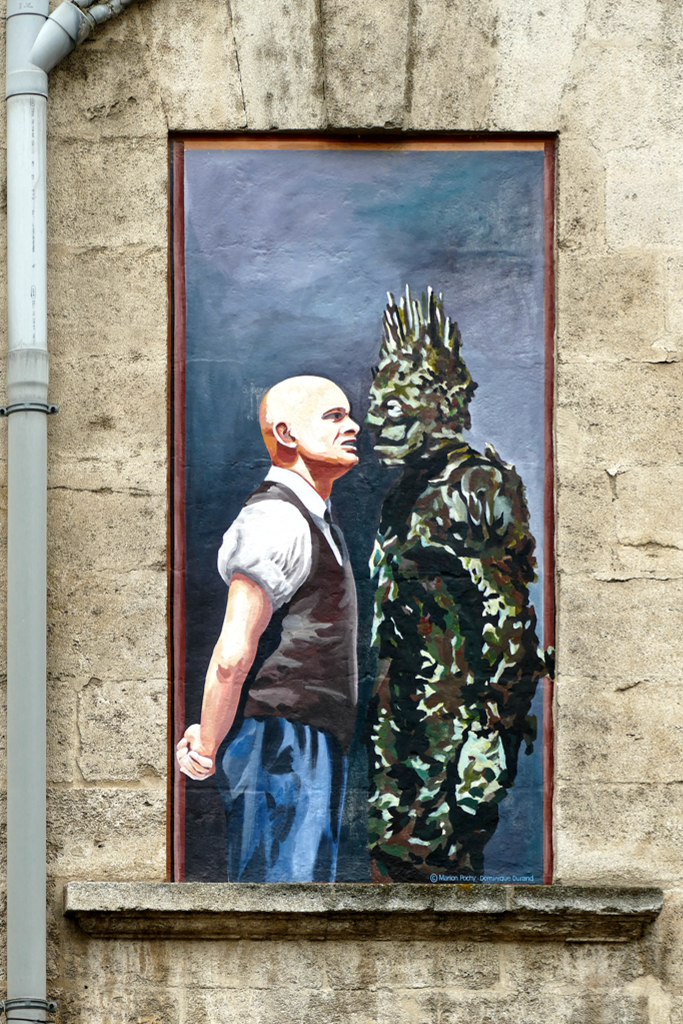

Well, you may know that houses in Amsterdam are very narrow and very deep towards the back because the owners were taxed according to the width of the house. A similar reason lies behind the bricked-up windows. In France, they charged a window tax for about 100 years starting in 1798. The amount was calculated based on the number of windows in a house. The windows facing the street were used as a calculation basis, and blind windows were exempt from tax. That’s why clever bargain hunters simply blocked or bricked up a few windows. They gave up some daylight, but saved money.
Even after the tax was abolished, many people simply left their windows bricked-up.



Since 1947, Avignon has been transformed into a humongous theater stage for three weeks every July. That’s when one of the world’s largest festivals for dance, theater, and music takes place.
In 1986, the artists Marion Pochy and Dominique Durand began painting the bricked-up windows according to the performances. To this day, scenes from famous productions from the festival’s history can be traced on around 70 windows across Avignon.
Madonnas in Avignon
Left of the Papal Palace is Avignon’s Notre Dame Cathedral. Although there has been a cathedral in that spot since the 12th century, much of what you can see today is a subsequent reconstruction. A golden Madonna is giving the city her blessing from the top of the tower.

And also the most important masterpiece in the Petit Palais Museum is an image of a Madonna, namely Botticelli’s famous Madonna and Child from 1467.


But those two ladies are not the only ones. Since there is a prevailing belief that Madonnas protect the city, its houses, and its residents, they stand at every corner – literally. So-called house madonnas are emblazoning many house corners and richly decorated niches, or they are standing above window arches. As a matter of fact, there are more than 80 of these mini statues in the city of Avignon!


The Marian cult, already very widespread in the Middle Ages, experienced a new impetus with the Catholic reform in the 17th century. Provence was the flagship of the Counter-Reformation in France. Therefore, numerous Marian shrines were built and private houses were also decorated with small statues of the Virgin Mary. Maria also became the most common female first name in the 18th and 19th centuries, especially in Provence.
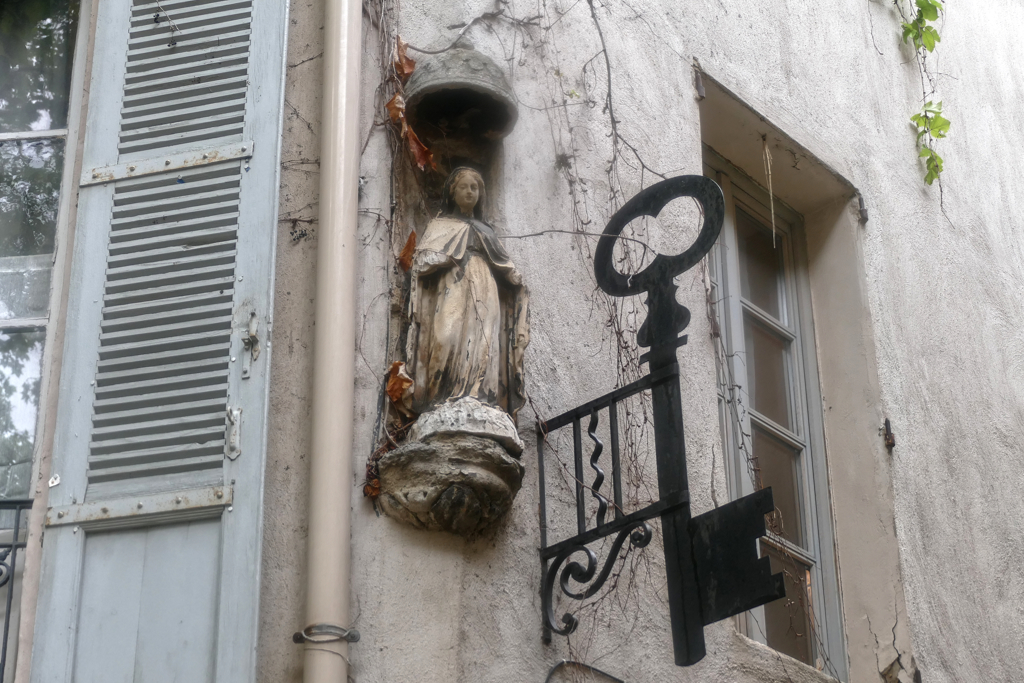

Theater in Avignon
As I mentioned above, the Avignon Festival is one of the world’s most important theater, dance, and music festivals. Since Jean Vilar founded this mega-event in 1947, it has taken place every year during the last three weeks of July.
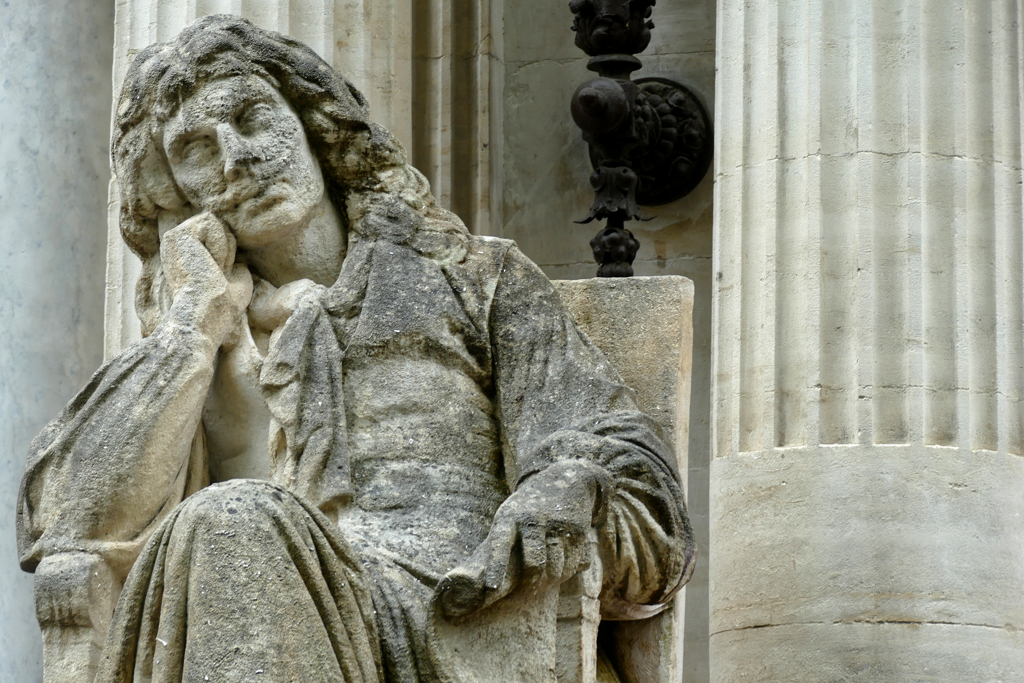
In addition to the main performances which are sponsored by official associations and take place in the Papal Palace, the Carmelite Monastery, and other honorable venues, there are hundreds of off-performances. Small theater groups and individuals perform in privately run theaters, in backyards, or right on the street.
In general, there is a lot going on in the streets of Avignon during the festival, especially in the square in front of the Papal Palace and the Place de l’Horloge.
You can check what’s planned for this year on their website. Since ticket sales have already begun, you should make your booking quickly if you want to attend this year’s 78th edition.
Murals in Avignon
Unfortunately, this part of the post will remain unexpectedly short. This is particularly a shame because one of the main reasons for my trip to Avignon was actually the street art. I had read that there were controversial political works that caused a stir and were then officially removed. That didn’t sound too bad, and I really wanted to get to know Avignon’s rebellious side. But then it rained all day.

Even in places like Vienna, where I had specific addresses where to find murals, the search took hours. First, I had to check on which side of the wall and in which hidden corner the work actually was. Then I had to find a good angle so that my photo does the mural justice. Also, at times, the address just wasn’t quite right so I had to search the entire neighborhood.
Honestly, I simply didn’t want to subject my camera and myself to this hassle in the pouring rain of Avignon.
So no street art for me.
Whereby, strictly speaking, the house madonnas are urban art, although not according to today’s understanding. And the wonderful window paintings by Marion Pochy and Dominique Durand made totally up for controversial murals, anyway.

I spotted the two murals that you see here on my way to the ApartHotel Sainte-Marthe**. Aside from street art, Rue Carreterie, has nice restaurants, adorable little shops, and an overall very cool vibe. You should definitely check it out when visiting the city.
As for me, I have to put off the street art hunt until my next visit to Avignon, which will certainly be soon and hopefully in bright sunshine.
Practical Information
How to Get There
By Plane
The airport Avignon-Provence is located southwest of the city center, but there are no regular flight connections. However, it is served seasonally by airlines from Great Britain.

The best airport to get to is the one in the vicinity of Marseille. From there it is around 80 kilometers to Avignon, which takes one to one and a half hours by train. You first need to take bus #13 from the airport’s Gare Routière to the train station Vitrolles. From there, take one of the regional trains whose number starts with TER. A general single trip costs around 20 €uros and the ride takes about a bit over an hour.
Then, Lyon’s Saint-Exupéry Airport is 240 kilometers away, however, there are direct TGVs that reach Avignon TGV station in under an hour and Avignon-Centre in an hour and a half. One-way trips start at 29 €uros, but should be booked well in advance, especially during high season.
By Train
Avignon has two train stations. Firstly, there is Avignon Centre on the southern edge and within walking distance of the old town.
Then, there is Avignon TGV located around four kilometers south of the city center. This is the hub for high-speed trains coming from Paris and Lyon in the north respectively Marseille and Nîmes in the south. Avignon can also be reached directly from Paris Charles-de-Gaulle Airport by TGV in less than two hours. However, keep in mind that reservations are mandatory when taking the TGV. During the high season, make sure to book well in advance.
There are also few direct connections to other countries, for example to Basel in Switzerland and Frankfurt am Main in Germany.
You can get information and book tickets online on the website of the national train company SNCF.
Annoyingly, there is no luggage storage at any of the train stations or anywhere around town, for that matter. Keep that in mind as you are booking your accommodation!
By Bus
Travelling by long-distance bus is getting really popular in Europe. I was pretty amazed when I found out that my connection from Avignon to my next destination Aix-en-Provence was twice as fast by bus than by train. For 20 €uro, the coach from Avignon’s Pôle d’Echanges Multimodal bus terminal, in short PEM, took me to the center of Aix in just under an hour. If I had taken the train, I would have had to change at least once, and it probably would have cost me a lot more. Hence, it is always worth comparing the travel times and prices of buses and trains.
There are not only two train stations in Avignon, but also several bus terminals. The PEM bus station is right next to the train station in the city center, south of the magnificent city walls. Then, there is Avignon Post, and Le Pontet, from where most long-distance routes are served for instance by FlixBus. So it’s crucial to check exactly where your bus leaves from before you head to the bus station.
How to Get Around
Every spot in Avignon’s old town can be reached on foot in about twenty minutes max. I even walked from the city center to the ApartHotel Sainte-Marthe** located just behind the northeastern part of the old city wall. However, as you’ll still walk a lot and the ancient structures of the Palace as well as the bridge are not that easily climbed, make sure to wear sensible shoes, preferably sneakers.
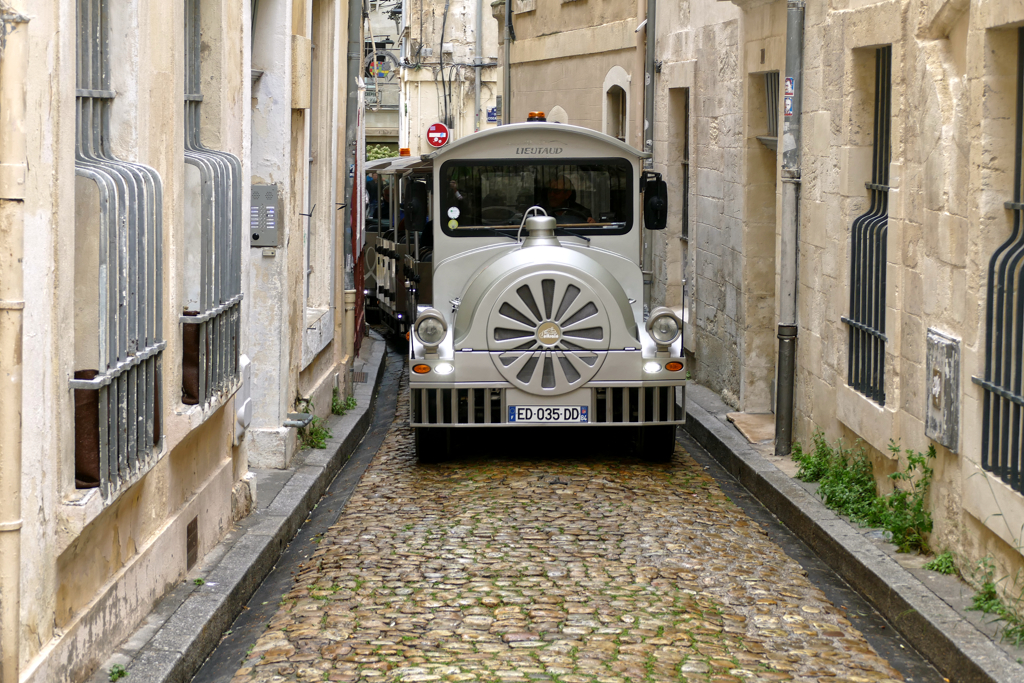

Obviously, you can also rent a bike. In contrast to, for example, Arles or Marseille, Avignon is fairly flat, which makes cycling an unrestricted pleasure.
Avignon’s bike rental company is called Vélopop. Doesn’t that already sound fun? You have to download their App and create an account. Then, you can choose from their different plans. As a visitor, you will probably opt for the 24-hour version. After you have paid a basic amount of 1 €uro, you pay 0.50 €uros for every 30 minutes started. For the 7-day plan, you pay 5 €uro, albeit, the half-hourly fee remains the same. Vélopop has an excellent website that explains everything in detail and also allows you to contact customer service if there is any problem.
However, there is a comprehensive network of buses in Avignon. A single ticket costs as little as 1.30 €uros and is valid for one hour. Yet, if you plan to take the bus more often, a day pass for 4 €uros might be a better deal.
Where to Stay
One of the great advantages of French centralism is that also those totally preposterous prices stay in the capital. As soon as you leave Paris, things get significantly cheaper and this applies to accommodation, too.



It’s an easy equation: Of the three aspects of a good standard, convenient location, and affordable price, you always have to waive one. If you find a good standard hotel in a convenient location, it won’t be at an affordable price. A hotel in a convenient location at an affordable price won’t have a good standard. And finally, a good hotel at an affordable price won’t be in a convenient location.
I opted for the last option which brought me to the outskirts northeast of the old town to Avignon’s university neighborhood. To get there, I walked from the city center for twenty minutes. Nevertheless, there are various buses going to the area, hence, you’ll get by no means stuck.
The room I booked at ApartHotel Sainte-Marthe** was in fact a small apartment with a huge bed, a bathroom, and even a fully equipped kitchenette. Since the price was really reasonable, it should be perfect even for a longer stay. Although you have your own kitchen, you can always enjoy their breakfast which costs 13 €uros extra. That’s not crazy expensive but no bargain, either.
In case they are booked out or if you simply prefer a different kind of accommodation, you can choose suitable lodging options in Avignon on this map**:
Booking.comWhat to Eat
French cuisine is famous all over the world for a reason. In fact, food is an important part of daily life in France and regional cuisines and customs are a cherished part of the national culture. UNESCO recognized France’s efforts and designated the country’s national cuisine as an intangible cultural heritage in 2010.
French dishes are famed for their sophistication and versatility and, most importantly, the high quality of the ingredients used. Of course, each region has its own specialties, but they are often popular throughout the country. The most famous dishes come from Normandy, Brittany, Burgundy, and the Provence region, obviously.
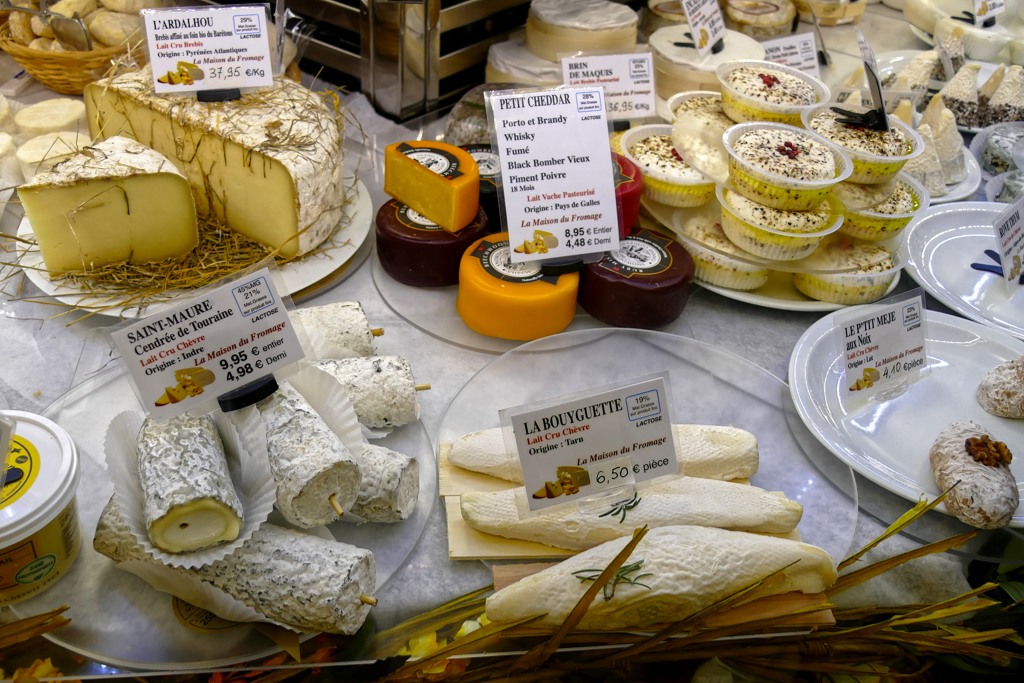

In addition to delicious wine and crispy baked goods, more than 700 types of cheese are particularly noteworthy! In fact, the French don’t just slap cheese on a sandwich. They also use it a lot for cooking, gratinating, or as a filling.
Unfortunately, food in France is not cheap. In general, lunch menus and daily specials, so-called plat du jour, are comparatively affordably priced. Delicious snacks at reasonable prices are often available in bakeries and rotisseries as well as in Avignon’s covered market hall.


Also, if your accommodation offers breakfast at a halfway reasonable price, take it. Albeit, you can always grab a croissant and a café au lait at many bakeries. However, since you can take as much coffee and salty and sweet pastries as you like, you will probably get a better price at the hotel as long as the amount doesn’t exceed let’s say 12 euros.
Cash, Cards, and Deals
Since 2001, 20 European countries have paid with €uros, and France is one of them, obviously. The exchange rate is 1 US$ = 0,93 EUR as of June 2024, but you can check the conversion on this page.
Also, you can pay with credit cards basically everywhere.
Although Avignon is by far not as expensive as for instance Paris, visiting all the amazing landmarks quickly adds up. You can save quite a bit of money with the Avignon City Pass*, as it grants you free entry to the city’s main attractions and museums. In addition, you get a discount on certain activities and services, and it even comes with the right to a parking space at the Palais des Papes parking lot. This, of course, applies exclusively during the validity period of the pass. However, that’s the first time I’ve heard of a service like this.
The pass comes in two versions and can also be comfortably ordered online*. However, if you get your pass in person at the Office de Tourisme d’Avignon, you can add the option of free use of public transport at no extra charge! Isn’t that amazing?
| 24 hours | 48 hours |
| 24 €uros | 32 €uros |
Visiting Organized
Although I’m an avid solo-travelling woman, I sometimes like to join organized tours. This way, I get extended info about a place and it’s fun to visit landmarks in the company of like-minded fellow travellers.
Especially in summer when the lavender is in full bloom, Avignon can get quite busy. Therefore, booking tickets’n’tour ahead is certainly a good idea**:
Connection and Communication
Since June 2017, no roaming charges have applied within the EU with a European mobile phone contract, This applies in all 27 countries of the European Union as well as in Iceland, Liechtenstein, and Norway and to all contracts.
In case European roaming is unavailable, you can connect to the internet without any issue at basically every museum, eatery, café, and, of course, hotel.
If you insist on being online 24/7, you can get a SIM card, obviously. There are prepaid SIM cards by many companies. The cheapest one is distributed by Orange France and costs only 2.99 €uros. Other brands are SFR France, Bouygues Telecom, and Free Mobile. They cost 10 €uros. Keep in mind that some companies might also charge an activation fee.
In France, they use plug types C and E. Their voltage is 230 V and the frequency 50 Hz. Whereby, as nowadays, all these chargers have integrated adapters, in general, the voltage and frequency don’t really matter.
By the way, you’ll find this information and many more comprehensive travel tips in my post World’s Most Complete Travel Information – an indispensable globetrotter-classic.
Language
The French are famous for many great things. Presumably, speaking foreign languages is not one of those. While in über-touristy Paris, things seem to get a bit better, in the Provence region, people have rudimentary knowledge of English at most. And while they still might understand more or less what you are saying, they might not be able or willing to answer in English. Therefore, already out of respect, it won’t hurt to learn at least some polite phrases with the help of babbel or Lingohut, for example.
Map
This map should help you to find all the wonderful places I’m introducing in this post. Clicking on the slider symbol at the top left or the full-screen icon at the top right will display the whole map including the legend:
Avignon was only one of five amazing cities I visited during my circle trip through the Provence. To read about the others, go to the post France – An Easy Circle Trip to the Five Best Cities to Visit in Provence and take your pick! There, you’ll also find further valuable general information that will make your own trip much smoother and more enjoyable.
Pinnable Pictures
If you choose to pin this post for later, please use one of these pictures:












Did You Enjoy This Post? Then You Might Like Also These:
The Best Beaches in Guadeloupe You Can Easily Visit by Public Bus
Cheesy Flight: Never Put Cream Cheese In Your Hand Luggage
One Day in NÎMES – What Not to Miss in the Most Roman City of France
MAGNIFICENT MARTINIQUE: Ten Places Not to Miss on Your Visit (even when exploring by public bus)
Best Street Art in PARIS: How Mehdi Ben Cheikh Transformed the 13th Arrondissement Into An Open-Air Gallery
24 hours in PARIS
PARIS Museum Pass: Skip the Lines And See It All For Less
GRAND GUADELOUPE: Complete Guide And Perfect Itineraries (also for travels by public bus)
* I am very appreciative that Avignon Tourisme supplied me with a complimentary Avignon City Passt. Nevertheless, the description of these activities and all opinions on their services are mine and were in no way influenced by my cooperation partner.
** This is an affiliate link. Hence, If you book through this page, not only do you get the best deal. I also get a small commission that helps me run this blog. Thank you so much for supporting me!






